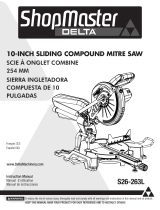
19
ENGLISH
1. Components and Parts
(standard delivery)....................18
2. Please read first!.......................18
3. Safety .........................................19
3.1 Specified Conditions of Use........19
3.2 General Safety Instructions ........19
3.3 Symbols on the Machine ............20
3.4 Safety Devices............................20
4. Installation and Transport........21
5. Special Product Features.........21
6. Machine Details.........................21
7. Initial Operation ........................22
7.1 Rotating Table Lock Screw
Installation...................................22
7.2 Connection of a Dust Collector ...22
7.3 Installing the Support..................22
7.4 Installing the Stock Stop .............23
7.5 Installing the Work Support.........23
7.6 Connecting the Chip Bag............23
7.7 Installing the
Work Clamp................................23
7.8 Mains Connection .......................23
8. Operation...................................24
8.1 Standard Cross Cuts ..................24
8.2 Mitre cuts ....................................24
8.3 Bevel Cuts ..................................25
8.4 Compound Mitre Cuts.................25
8.5 Grooving .....................................25
8.6 Support .......................................26
8.7 Stock Stop ..................................26
8.8 Work Clamp ................................26
8.9 Laser...........................................26
9. Care and Maintenance..............27
9.1 Changing the Saw Blade ............27
9.2 Replacing the Batteries...............28
9.3 Replacing the Table Insert..........28
9.4 Adjustments ................................28
9.5 Machine Cleaning .......................29
9.6 Machine storage .........................29
9.7 Maintenance ...............................29
10. Tips and Tricks .........................29
11. Available Accessories.........29/62
12. Repairs.......................................29
13. Environmental Protection ........29
14. Troubleshooting Guide ............29
15. Technical Specifications..........30
15.1 Available Saw Blades ................31
These instructions have been written in
a way which facilitates learning of how to
safely operate your saw. These instruc-
tions should be used as follows:
Read these instructions before use.
Pay special attention to the safety
information.
These instructions are intended for
persons having a basic technical
knowledge of the operation of
machines such as the one
described herein. If you have no
experience whatsoever, we strongly
recommend to seek the advise of an
experienced person.
Keep all documents supplied with
this machine for future reference.
Retain proof of purchase in case of
warranty claims.
If you lend or sell this machine be
sure to have these instructions go
with it.
The equipment manufacturer is not
liable for any damage resulting from
neglect of these operating instruc-
tions.
Information in these instructions is indi-
cated as under:
Danger!
Risk of personal injury or
environmental damage.
Risk of electric shock!
Risk of personal injury
by electric shock.
Drawing-in/trapping haz-
ard!
Risk of personal injury
by body parts or clothing
being caught.
Caution!
Risk of material damage.
Note:
Additional information.
At times, numbers are used in illus-
trations (1, 2, 3, ...). These numbers
indicate component parts;
are consecutively numbered;
relate to the corresponding
number(s) in brackets (1), (2), (3)
... in the neighbouring text.
Instructions to be carried out in a
certain sequence are numbered.
Instructions which can be carried
out in any sequence are marked by
a bullet point (•).
Listings are marked by a dash (–).
3.1 Specified Conditions of
Use
This saw is intended for cross cuts,
bevel cuts, mitre cuts, and compound
mitre cuts of strips, profiled ledges, etc.
Grooving is also possible as well. Only
such materials suitable for cutting by the
saw blade fitted may be cut (see "Tech-
nical Specifications" for available saw
blades).
The permissible workpiece dimensions
must be observed (see "Technical Spec-
ifications").
Stock having a round or irregular cross
section (such as firewood) must not be
cut, as it cannot be securely held during
cutting. When sawing thin stock layed on
edge, a suitable auxiliary fence must be
used for firm support.
Any other use is not as specified.
Unspecified use, alteration of the
machine, or use of parts not approved
by the manufacturer can cause unfore-
seeable damage!
3.2 General Safety Instruc-
tions
x When using this machine observe
the following safety instructions, to
minimise the risk of personal injury
or material damage.
x Please also observe the special
safety instructions in the respective
chapters.
x Where applicable, follow the legal
directives or regulations for the pre-
vention of accidents pertaining to
the use of crosscut saws.
A
General hazards!
x Keep your work area tidy – a messy
work area invites accidents.
x Be alert. Know what you are doing.
Set out to work with reason. Do not
operate the tool while under the
influence of drugs, alcohol or medi-
cation.
x Consider environmental conditions:
keep work area well lighted.
x Prevent adverse body positions.
Ensure firm footing and keep your
balance at all times.
x Do not operate the tool near inflam-
mable liquids or gases.
x This tool shall only be started and
operated by persons familiar with
crosscut saws, and who are at any
time aware of the dangers associ-
ated with the operation of such tool.
Persons under 18 years of age shall
use this tool only in the course of
their vocational training, under the
supervision of an instructor.
Table of Contents
2. Please read first!
3. Safety
















